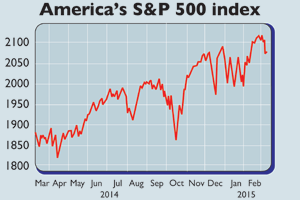
Good news, it seems, is bad news for equities. In February US payrolls again beat expectations, expanding by 295,000. The unemployment rate declined to 5.5%, the lowest level in almost seven years. US stocks promptly swooned, posting their worst day in two months.
The problem for markets is that a stronger economy implies higher interest rates in America, which would restrict the liquidity that has been sloshing into stocks at an unprecedented rate over the past few years. US rates have been at practically zero since the crisis – and they’re not alone.
More than 80% of global market capitalisation is supported by zero-interest-rate policies, says Michael Hartnett of Bank of America Merrill Lynch. This almost-free money has leaked into asset markets and papered over the lacklustre fundamentals. Investors both in the US and elsewhere have got so used to it, they are having withdrawal jitters before the drugs are even taken away.
But it looks as though US investors will soon have to go cold turkey. The US Federal Reserve “is gradually running out of reasons not to raise rates” from emergency levels, as David Fuller puts it on fullertreacymoney.com.
While inflation has been subdued, there are signs that wage growth will soon improve more strongly. Wages are climbing at an annual rate of 2%, and they tend to be a lagging indicator. So if the Fed waits for them to rise faster, it could end up letting inflation get out of control. The markets are pencilling in a first rate hike in June.
History shows that US stocks wobble in the run-up to rate hikes. But then investors realise they’re a sign that the economy’s engine is strong enough to cope with a small application of the brakes. Stocks are usually higher a few months after rate rises begin.
However, these are uncharted waters. Equities have never enjoyed this much liquidity for so long, and debt levels in advanced economies are far higher than before the last rate cycle.
Earnings are a further headwind. The stronger dollar and lower oil prices have already undermined profits; now the improving job market will increase pressure on wages. S&P 500 earnings now look set to decline for two successive quarters, which hasn’t happened since the crisis.
Meanwhile, valuations haven’t factored in potential disappointments. The S&P’s cyclically adjusted price/earnings ratio is 27 – higher than it has been over 90% of the time since 1928.